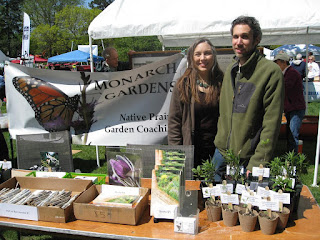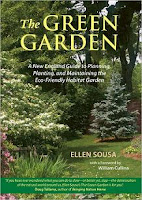I've always wanted to have a giveaway, so why not include my friends at
Native Plants & Wildlife Gardens and
Beautiful Wildlife Garden.
Leave a comment ranking your choices in order of preference. I'll use a random number generator, and when I land on your comment, I'll go down the list and give you the first available prize (you can also just say "yo" and I'll randomly hand out a prize). I'll then hook you up with the author so they can send you the book.
You have until Saturday, December 8 at midnight central to enter. So, get to it! And please help me spread the word. Karma is a factor for the random number generator.
THE WINNERS
Pat Musick -- Urban and Suburban Meadows by Catherine Zimmerman
Gaia Gardener -- Energy-Wise Landscape Design by Sue Reed
Subversive Hippy -- Nature's Notes by Judy Burris
Jenny Brooks -- Florida Butterfly... offered by Suzanne Dingwell
Unknown (who are you?) -- Rocky Mountain Garden by Susan Tweit
Sunnyside Dru -- The Green Garden by Ellen Sousa
Diane S -- Sleep Creep Leap by moi (others were taken, so you win mine!)
Jchapstick -- Sleep Creep Leap by moi
Send me an email (bervogtATgmail.com) with mailing address so I can put you in touch with the authors!
#1
60 minute companion video
The video brings into focus the amazing
diversity of life inhabiting meadows and prairies and the beautiful
imagery inspires meadow and prairie creation! The 60-minute video is formatted to be screened in one sitting or the viewer can click on individual chapters with meadow experts
Michael Nadeau,
Larry Weaner and
Neil Diboll, who walk the viewer through meadow site preparation, design, planting and maintenance. In the chapter,
Why Native Plants, entomologist,
Doug Tallamy, author of
Bringing Nature Home, explains the intrica
te connection between native plants, native insects and the soil food web.
The video and book address the problems
caused by the extensive planting of pesticide-ridden, non-native grass
lawns across America. While it is impractical to eliminate lawn, we
cannot ignore the environmental consequences of such landscape planning
as ecosystems are being destroyed and replaced with chemically
maintained monocultures.
#2
Residential consumption represents nearly one quarter of North America’s
total energy use and the average homeowner spends thousands of dollars a
year on power bills. To help alleviate this problem, Energy-Wise Landscape Design
presents hundreds of practical ways everyone can save money, time, and
effort while making their landscapes more environmentally healthy,
ecologically rich, and energy efficient.
Intended for homeowners, gardeners, landscape professionals, and
students, the design ideas in this book will work in every type of
setting—large or small, hilly or flat, urban or rural. Written in
non-scientific language with clear explanations and an easy
conversational style, Energy-Wise Landscape Design is an
essential resource for everyone who wants to shrink their energy
footprint while enhancing their property and adding value to their home.
#3
Regardless of age, we all enjoy the fun of discovering new insights to our natural world.
Nature's
Notes delivers this joy using bite-sized learning text and dazzling
close-up photos to unlock scores and scores of fascinating secrets. The
fast-paced format features mini articles and sidebars interspersed with
fun and affordable projects as well as backyard explorations revealing
hidden natural treasures.
Nature's Notes unique spiral-binding and flexible jacket make this eye-popping book both sturdy and outdoor-friendly . Author/photographers Judy Burris and Wayne Richards have had their work featured in national and worldwide magazines, while their award-winning books, The Secret Lives of Backyard Bugs and The Life Cycles of Butterflies are national nature-category best sellers.
#4
Marc Minno, Jerry Butler, Donald Hall
This book will become the classic guide to southern butterfly caterpillars and their host plants.
With
hundreds of color photographs and concise information in a format that
can easily be carried into the field, it offers an unprecedented tool
for all butterfly gardeners, teachers, naturalists, students, and
scientists in the southern United States.
No other book offers
such a comprehensive discussion of Florida butterfly caterpillars and
their host plants. It covers caterpillar anatomy, biology, ecology,
habitat, behavior, and defense, as well as how to find, identify, and
raise caterpillars. The book contains sharply detailed photos of 167
species of caterpillars, 185 plants, 18 life cycles, and 19 habitats. It
includes 169 maps. Photos of the egg, larva, pupa, and adult of
representatives of 18 butterfly families and subfamilies provide life
cycle comparisons that have never been illustrated before in such an
accessible reference.
#5
Rocky Mountain gardeners of all skill levels can now breath a sigh of relief. Keep
gardens healthy and productive with the quick, expert advice provided
in this easy-to-use pocket-size guide. Within these pages you will find
the necessary resources and tools to adjust to the challenges of living
in the rugged Rocky Mountains. Gardeners in Montana, Idaho, Wyoming,
Colorado, Utah, Arizona, and Alberta and British Columbia, Canada, will
find down-to-earth tips on:
*Growing the right plants for your geographic area
*Working with soil
*Understanding unique weather challenges
*Getting rid of "invaders"—weeds and pests
#6
Ellen Sousa
This
practical, comprehensive and inspirational guidebook for New Englanders
looking for low-cost, beautiful and earth-friendly ways to green their
landscapes and outdoor spaces and supply habitat for a variety of
declining species, including birds, native pollinators, honey bees,
amphibians and turtles.
Includes
an extensive Plant Guide, detailing the best wildlife-friendly plants
suitable for the varied conditions and microclimates across New England,
cultivation hints and tips, and the wildlife attracted by each plant.
#7
Benjamin Vogt
Peeling
off sheets of skin from a sunburned back. Spending $1,000 at five
nurseries in an afternoon. Raising 200 monarch butterflies. Hearing the
wing beats of geese thirty feet overhead at sunset. How one piece of
mulch can make all the difference. These are the stories of Benjamin
Vogt’s 1,500 foot native prairie garden over the course of three years.
After a small patio garden at his last home teases him into avid
tinkering, the blank canvas of his new marriage and quarter acre lot
prove to be a rich place full of delight, anguish, and rapture in all
four seasons.
Full of lyrical, humorous, and botanical short essays, Sleep, Creep, Leap
will leave you inspired to sit a while with your plants, noticing how
the smallest events become the largest—and how the garden brings us down
to earth so that we can come home to our lives.



.JPG)














































